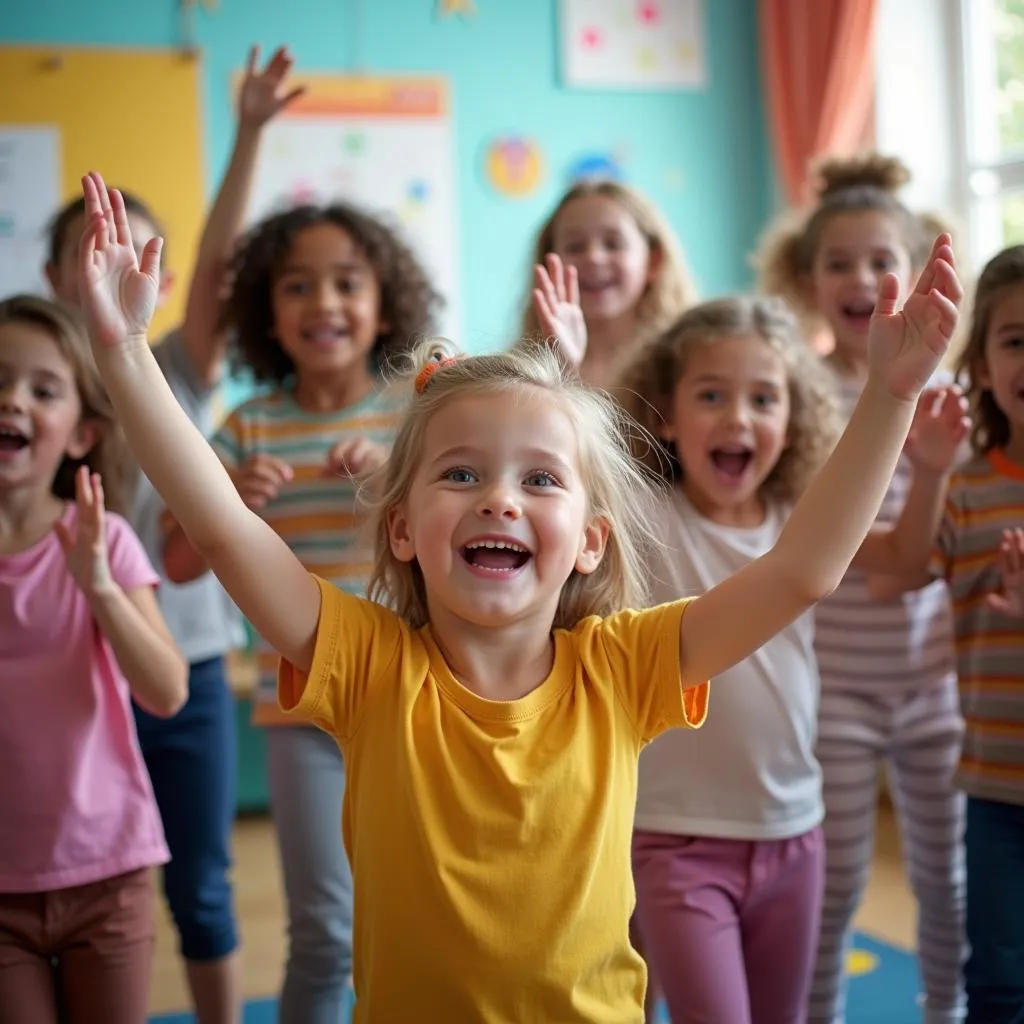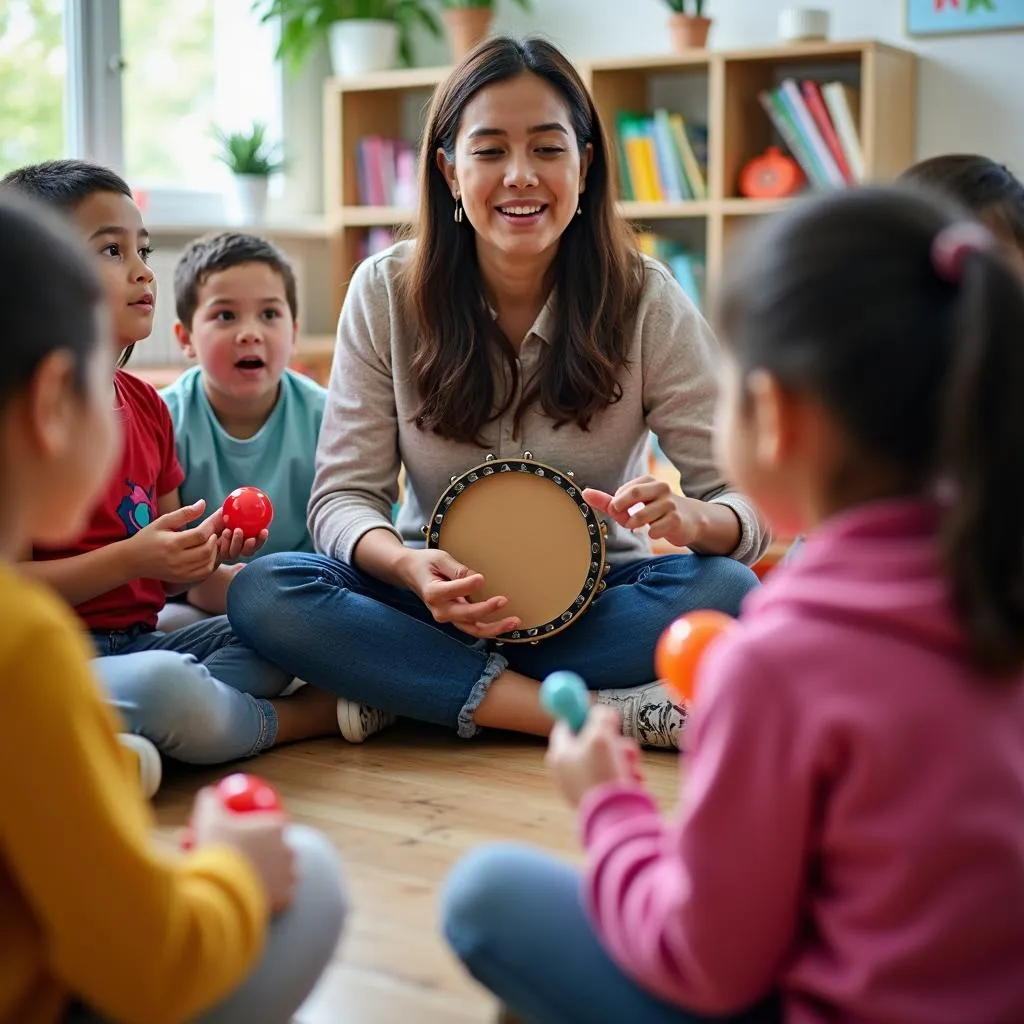“Ầu ơ… Ví dầu cầu ván đóng đinh…” – Is there any teacher who hasn’t hummed these pure, innocent childhood melodies? Preschool music class is more than just teaching songs; it’s an art of sowing seeds of love, nurturing sensitive and delicate souls in young children. So, how can we create engaging and effective preschool music classes? Let “TUỔI THƠ” guide you through the secrets to “infuse soul” into music, turning each lesson into a colorful playground!
Preschool Music: Nurturing Young Hearts with Love
Just as poet Xuân Quỳnh wrote: “Green bamboo, how long have you been green? Green since you were buds, bamboo shoots,” children’s souls are also pure and innocent from the beginning. And music is a magical “tonic” that enriches and beautifies these souls.
Ms. Nguyễn Thị Hoa, a veteran preschool teacher at Hoa Sen Kindergarten in Hanoi, with over 20 years of experience, shares: “Music has a magical power; it’s like a cool stream watering children’s souls, making them brighter and more innocent.”
Benefits of Music for Preschoolers
Music is not just about enjoyable tunes; it brings countless wonderful benefits to a child’s overall development:
- Language Development: Songs with familiar, easy-to-remember lyrics help children learn their mother tongue naturally and effectively.
- Emotional Expression: Music is the language of the soul, helping children recognize and express emotions genuinely and purely.
- Imagination Stimulation: The rich melodies and lyrics of music are excellent catalysts for children’s boundless imagination.
- Physical Development: Music activities combined with movement help children improve physical fitness and develop agility.
- Social Skills Development: Participating in group music activities helps children learn to cooperate, share, and connect with friends.
 Preschool children actively participate in a music lesson, singing and moving their bodies
Preschool children actively participate in a music lesson, singing and moving their bodies
Teacher’s Secrets: The Art of Creating Engaging Preschool Music Classes
So, how can we create engaging and effective preschool music classes that help children learn while playing, unleash their creativity, and develop holistically?
1. Choose Appropriate Songs
Songs are the soul of a music lesson. Choosing songs that are appropriate for the theme, age group, and psychology of children is a prerequisite for ensuring the success of the lesson.
- Familiar Themes: Prioritize songs with themes that are close to children, revolving around familiar topics such as family, friends, school, objects, animals, etc.
- Cheerful Melodies: Upbeat and lively melodies will easily attract attention and create excitement for children when participating in the lesson.
- Easy-to-Remember Lyrics: Choose songs with simple, understandable, and easy-to-remember lyrics that are suitable for children’s learning abilities.
2. Use Diverse Organizational Forms
To avoid boredom, teachers should flexibly use a variety of forms to organize music activities, such as:
- Group Singing: Helps children get used to singing in groups, develop confidence, and practice vocal harmony skills.
- Call and Response Singing: Creates excitement and stimulates the spirit of learning and competition among children.
- Singing Combined with Movement: Helps children develop physically, improve agility and dexterity.
- Listening to Music and Moving to Music: Develops the ability to perceive music and express emotions through melodies.
- Singing and Playing Rhythm Instruments: Develops a sense of rhythm and harmonious coordination between hands and mouth.
Engaging preschool music class examples are often creatively organized lessons that harmoniously combine various forms and teaching methods.
3. Create a Lively Music Space
A beautifully and vividly decorated music space will inspire and stimulate children’s creativity. Teachers can:
- Decorate the Music Corner: Use pictures, drawings, musical instrument models, handmade items, etc., to create a lively and eye-catching music corner.
- Use Musical Instruments: Let children interact with and become familiar with simple musical instruments such as rattles, bamboo clappers, horns, shakers, etc.
You can find more ideas in the article preschool music corner decoration ideas.
 A preschool teacher guides children in a music activity, singing and playing rhythm instruments like shakers and tambourines
A preschool teacher guides children in a music activity, singing and playing rhythm instruments like shakers and tambourines
4. Combine with Other Activities
To add more fun and effectiveness to the lesson, teachers can integrate music into other activities such as:
- Storytelling: Use music as a background for stories to make them more vivid and engaging.
- Drama: Integrate songs that are appropriate to the content of the play to help children easily embody characters and express emotions.
- Drawing: Let children listen to music and draw pictures based on the song’s content to stimulate imagination and creativity.
In addition, teachers can also refer to the preschool fruit poem to integrate into music activities for added liveliness.
5. Create Closeness and Friendliness
Be a friend, a psychological guide, encourage confidence, and create a comfortable feeling for children when participating in music activities.
- Use Friendly Language: Communicate with children using simple, easy-to-understand, close, and friendly language.
- Praise and Encourage: Always pay attention to, monitor, and promptly encourage children’s learning spirit.
- Respect Differences: Each child is a unique individual; respect differences and maximize the potential of each child.
Conclusion
Music is a priceless gift that nature has bestowed upon humanity. For preschoolers, music is not just fun and entertainment, but also a means to help them develop comprehensively. We hope that with the useful sharing above, teachers will confidently create truly engaging and meaningful music “parties” for children!
To update more useful knowledge about preschool education, please visit preschool module 34 summary.
Contact us immediately via phone number: 0372999999 or come directly to the address: 234 Hao Nam, Hanoi for the best advice and support. “TUỔI THƠ” always accompanies you on the journey of sowing seeds of love for the future generation!